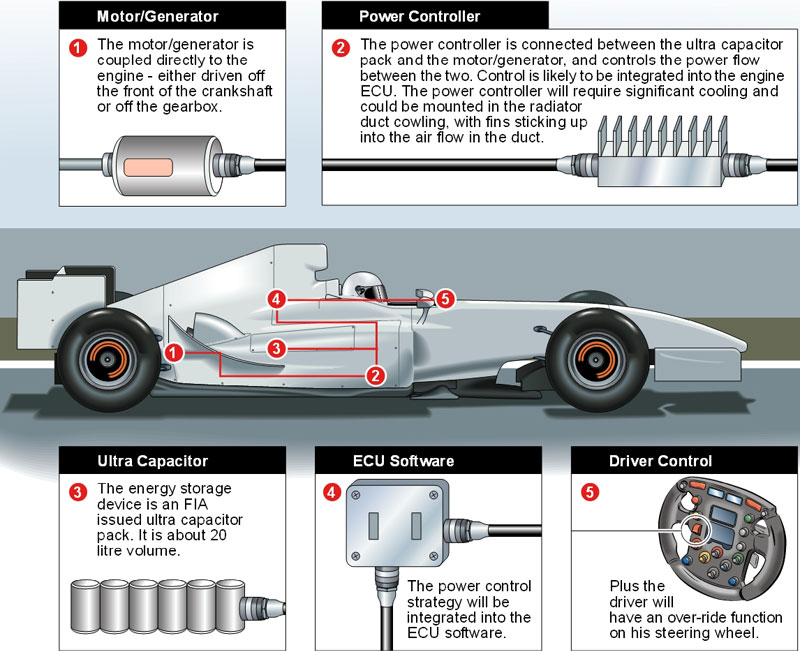Energy Recovery
Formula One cars feature many advanced
technologies to maximize the performance and efficiency of the
cars. Energy recovery has become a critical technology in
recent years. The following is a summary of the energy
recovery systems found on Formula One cars.
KERS
"Kinetic Energy Recovery System (KERS)...was introduced to the sport in 2009 and was a mainstay from 2011. KERS worked by harnessing waste energy created under braking and transforming it into electrical energy, providing an additional 60kW (approximately 80bhp) of power for up to 6.67 seconds per lap" (formula1.com).

ERS
Energy Recovery System (ERS) is an updated version of the KERS technology launched for the 2014 Formula One season. The system is known as a Motor Generator Unit (MGU) and incorporates two methods of energy recovery, kinetic (MGU-K) and heat (MGU-H).
"The motor generator units convert mechanical and heat energy to electrical energy and vice versa. MGU-K works like an uprated version of KERS, converting kinetic energy generated under braking into electricity (rather than it escaping as heat). It also acts as a motor under acceleration, returning up to 120kW (approximately 160bhp) power to the drivetrain from the Energy Store.
MGU-H is an energy recovery system connected to the turbocharger of the engine and converts heat energy from exhaust gases into electrical energy. The energy can then be used to power the MGU-K (and thus the drivetrain) or be retained in the ES for subsequent use. Unlike the MGU-K which is limited to recovering 2MJ of energy per lap, the MGU-H is unlimited. MGU-H also controls the speed of the turbo, speeding it up (to prevent turbo lag) or slowing it down in place of a more traditional wastegate.
A maximum of 4MJ per lap can be returned to the MGU-K and from there to the drivetrain - thatís ten times more than with 2013ís KERS. That means drivers should have an additional 160bhp or so for approximately 33 seconds per lap" (formula1.com).
KERS
"Kinetic Energy Recovery System (KERS)...was introduced to the sport in 2009 and was a mainstay from 2011. KERS worked by harnessing waste energy created under braking and transforming it into electrical energy, providing an additional 60kW (approximately 80bhp) of power for up to 6.67 seconds per lap" (formula1.com).

ERS
Energy Recovery System (ERS) is an updated version of the KERS technology launched for the 2014 Formula One season. The system is known as a Motor Generator Unit (MGU) and incorporates two methods of energy recovery, kinetic (MGU-K) and heat (MGU-H).
"The motor generator units convert mechanical and heat energy to electrical energy and vice versa. MGU-K works like an uprated version of KERS, converting kinetic energy generated under braking into electricity (rather than it escaping as heat). It also acts as a motor under acceleration, returning up to 120kW (approximately 160bhp) power to the drivetrain from the Energy Store.
MGU-H is an energy recovery system connected to the turbocharger of the engine and converts heat energy from exhaust gases into electrical energy. The energy can then be used to power the MGU-K (and thus the drivetrain) or be retained in the ES for subsequent use. Unlike the MGU-K which is limited to recovering 2MJ of energy per lap, the MGU-H is unlimited. MGU-H also controls the speed of the turbo, speeding it up (to prevent turbo lag) or slowing it down in place of a more traditional wastegate.
A maximum of 4MJ per lap can be returned to the MGU-K and from there to the drivetrain - thatís ten times more than with 2013ís KERS. That means drivers should have an additional 160bhp or so for approximately 33 seconds per lap" (formula1.com).